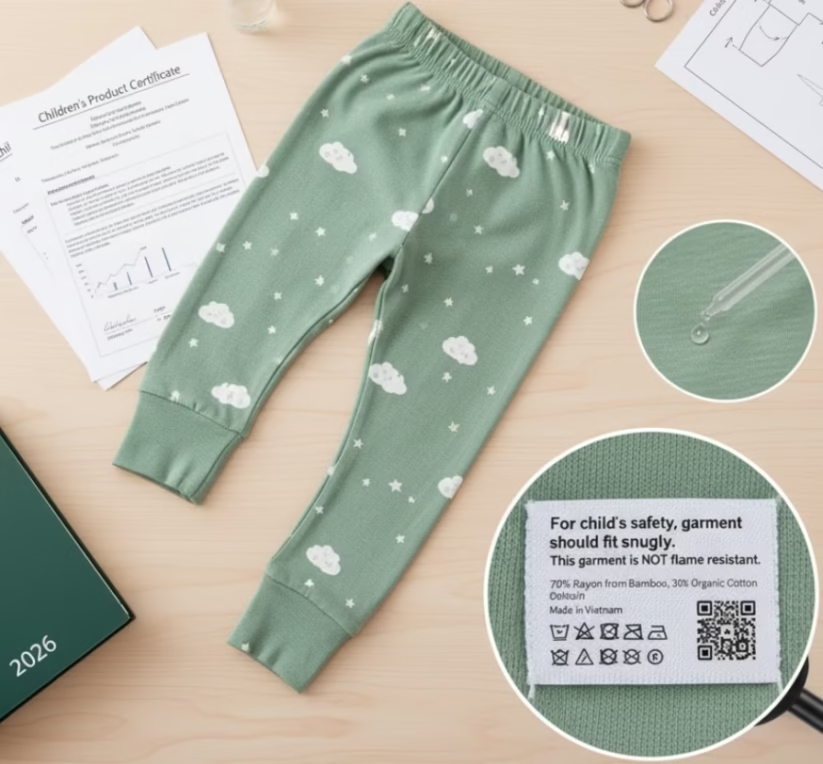In-Depth Guide to CPSIA Compliance for Bamboo Pajamas: Tight-Fit, Chemical Testing & Mandatory Labeling (2026)
🌟 Introduction: CPSIA and the Safety Challenge of Bamboo Pajamas
Contents
- 1 🌟 Introduction: CPSIA and the Safety Challenge of Bamboo Pajamas
- 2 1. The Flammability Standard: Tight-Fitting vs. Flame-Resistant
- 3 2. Chemical Testing Requirements: Lead, Phthalates, and Beyond
- 4 3. Essential Labeling and Tracking: The Permanent Identity
- 5 4. Mandatory Documentation & Certification: The Legal Proof of Compliance
The Consumer Product Safety Improvement Act (CPSIA) is the non-negotiable legal foundation for all children’s products (intended for children 12 or younger) sold in the United States. Bamboo pajamas are popular for their soft, breathable nature, but their underlying material is Rayon (or Viscose), which, if left untreated, is highly flammable like cotton.
For entrepreneurs planning to launch a bamboo baby clothing brand, compliance is the most significant hurdle and the basis for product pricing premium. This guide provides an in-depth breakdown of CPSIA compliance for bamboo pajamas across four core areas: Flammability, Chemical Content, Mandatory Labeling, and Documentation.
1. The Flammability Standard: Tight-Fitting vs. Flame-Resistant
The Core Rule:
Children’s sleepwear must comply with one of the following:
-
Flame-Resistant: Use chemically treated or inherently flame-resistant synthetic fabrics (like certain polyesters).
-
Tight-Fitting: Must meet the extremely precise dimensional tolerances set out in U.S. regulations to minimize air space and reduce the risk of fire spread.
The Bamboo Exception:
Most ethical and natural bamboo brands avoid chemical flame retardants, and thus must comply with the “Tight-Fitting Garment” requirements.
This means the pajamas must meet extremely specific measurement tolerances for the chest, waist, hips, upper arm, thigh, wrist, and ankle. This precise sizing is the most frequent area of failure in bamboo pajama compliance.
The Infant Exemption:
Garments in sizes $9$ months and under are generally exempt from the strict flammability standards (due to low mobility and reduced fire risk), but they must still meet the infant garment sizing requirements of $16$ C.F.R. $\S 1615.1(c)$.
The Yellow Warning Tag:
A mandatory yellow hangtag must be attached to all tight-fitting sleepwear (sizes larger than $9$ months) with the following warning:
“For child’s safety, garment should fit snugly. This garment is not flame resistant. Loose-fitting garment is more likely to catch fire.”
2. Chemical Testing Requirements: Lead, Phthalates, and Beyond
All accessible components of the children’s product must be tested by a CPSC-accepted, third-party laboratory.
| Chemical Standard | Requirement | Bamboo Pajama Components Involved |
| Lead Content | Total lead content in any accessible part must be $\le 100$ parts per million (ppm). | Zippers (sliders, pulls, teeth), snaps, rivets, and any screen-printing ink or plastic appliqués. The bamboo fabric itself must also be tested. |
| Phthalates | Restricted to $\le 0.1\%$ in child care articles (bibs, blankets, etc.) and children’s toys. | While clothing fabric is not usually the concern, plastic components like skid-stoppers on footies, certain screen-printing inks, or plastic zipper pulls must be tested. |
| Other Harmful Substances | OEKO-TEX Standard 100 Certification: Not federally mandated by CPSIA, but crucial for consumer trust. This tests the finished textile for over $100$ known harmful substances (pesticides, formaldehyde, heavy metals, etc.). | Finished fabric, threads, dyes, and trims. |
3. Essential Labeling and Tracking: The Permanent Identity
Every bamboo pajama product must have clear, permanent tracking and compliance labels.
| Labeling Element | Requirement | Purpose |
| Permanent Tracking Label | Must be permanently affixed (sewn-in) and include: 1) Manufacturer/Private Labeler Name, 2) Location and Date of Production, 3) Detailed Batch/Run Number (e.g., Garment Production Unit – GPU). | Allows for rapid recall identification in case of a safety issue. |
| Fiber Content & Care | Must comply with the FTC’s Textile Fiber Rule, requiring permanent care instructions. Crucially: Bamboo fabric must be labeled as “Rayon (or Viscose) Made from Bamboo”—never just “bamboo” as it is a chemically processed fiber. | Avoids FTC false advertising claims and ensures the garment maintains its shape/fit/safety through laundering. |
| Size | Must be clearly and permanently marked. | Essential for confirming the garment meets the strict snug-fit size requirements. |
4. Mandatory Documentation & Certification: The Legal Proof of Compliance
Compliance is not just about testing; it’s about the chain of proof.
| Document Requirement | Description |
| Children’s Product Certificate (CPC) | Mandatory for all children’s products sold in the U.S. A document created by the importer or domestic manufacturer that certifies, based on testing, that the product complies with all applicable CPSIA rules (Lead, Phthalates, Flammability). |
| Test Reports | Must be issued by a CPSC-accepted third-party laboratory. These reports must be readily available to the CPSC upon request and serve as the foundation for your CPC. You must obtain new test reports if the product design, materials, or manufacturing processes change. |
| Periodic Testing | Manufacturers must establish a periodic testing program to ensure ongoing compliance, especially when using the same fabric supplier (Fabric Production Unit – FPU). Testing should be done at set intervals (e.g., quarterly or after a certain number of production units) to prove consistent compliance. |
This multi-layered process ensures your bamboo pajamas are not only soft and cozy but legally safe for children. The Tight-Fitting standards are the most frequent area of failure, making precise sizing and pattern-making a non-negotiable step in the production process.
About the author
Xhiney, founder of Petelulu, brings over 20 years of experience in children’s wear design, production, and international trade. A contributor to Children’s Wear and Junior magazines, Xhiney has spent 17 years working with high-end children’s wear brands in Europe and the U.S., offering expert insights and support.

